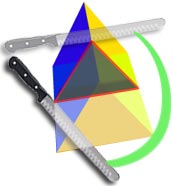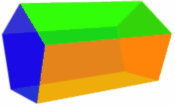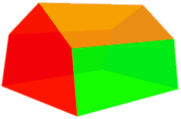Prisms Overview
A prism is a solid object with:
 The cross section of this object is a triangle ...
.. it has the same cross section all along its length ...
... so it's a triangular prism.
Bases: The ends of a prism are parallel
and each one is called a base.
The cross section of this object is a triangle ...
.. it has the same cross section all along its length ...
... so it's a triangular prism.
Bases: The ends of a prism are parallel
and each one is called a base.
 Sides: The side faces of a prism are parallelograms
(4-sided shapes with opposite sides parallel)
Sides: The side faces of a prism are parallelograms
(4-sided shapes with opposite sides parallel)
 These are all Prisms:
Rectangular Prism: Cross-Section:
These are all Prisms:
Rectangular Prism: Cross-Section:

 Cube: Cross-Section:
Cube: Cross-Section:

 Triangular Prism: Cross-Section:
Triangular Prism: Cross-Section:

 Pentagonal Prism: Cross-Section:
Pentagonal Prism: Cross-Section:

 Regular and Irregular Prisms:
All the previous examples are Regular Prisms, because the cross section is regular (in other words it is a shape with equal edge lengths, and equal angles.)
Here is an example of an Irregular Prism:
Regular and Irregular Prisms:
All the previous examples are Regular Prisms, because the cross section is regular (in other words it is a shape with equal edge lengths, and equal angles.)
Here is an example of an Irregular Prism:
Surface Area of a Prism:
 Surface Area = 2 × Base Area + Base Perimeter × Length
Example: What is the surface area of a prism where the base area is 25 m2, the base perimeter is 24 m, and the length is 12 m:
Surface Area= 2 × Base Area + Base Perimeter × Length
= 2 × 25 m2 + 24 m × 12 m
= 50 m2 + 288 m2
= 338 m2
Use the area calculation tool to find the area of bases: https://www.mathsisfun.com/area-calculation-tool.html
Volume of a Prism:
The Volume of a prism is the area of one end times the length of the prism.
Surface Area = 2 × Base Area + Base Perimeter × Length
Example: What is the surface area of a prism where the base area is 25 m2, the base perimeter is 24 m, and the length is 12 m:
Surface Area= 2 × Base Area + Base Perimeter × Length
= 2 × 25 m2 + 24 m × 12 m
= 50 m2 + 288 m2
= 338 m2
Use the area calculation tool to find the area of bases: https://www.mathsisfun.com/area-calculation-tool.html
Volume of a Prism:
The Volume of a prism is the area of one end times the length of the prism.
 Volume = Base Area × Length
Example: What is the volume of a prism where the base area is 25 m2 and which is 12 m long:
Volume= Area × Length
= 25 m2 × 12 m
= 300 m3
Volume = Base Area × Length
Example: What is the volume of a prism where the base area is 25 m2 and which is 12 m long:
Volume= Area × Length
= 25 m2 × 12 m
= 300 m3
- identical ends
- flat faces
- and the same cross section all along its length!
 The cross section of this object is a triangle ...
.. it has the same cross section all along its length ...
... so it's a triangular prism.
Bases: The ends of a prism are parallel
and each one is called a base.
The cross section of this object is a triangle ...
.. it has the same cross section all along its length ...
... so it's a triangular prism.
Bases: The ends of a prism are parallel
and each one is called a base.
 Sides: The side faces of a prism are parallelograms
(4-sided shapes with opposite sides parallel)
Sides: The side faces of a prism are parallelograms
(4-sided shapes with opposite sides parallel)
 These are all Prisms:
Rectangular Prism: Cross-Section:
These are all Prisms:
Rectangular Prism: Cross-Section:

 Cube: Cross-Section:
Cube: Cross-Section:

 Triangular Prism: Cross-Section:
Triangular Prism: Cross-Section:

 Pentagonal Prism: Cross-Section:
Pentagonal Prism: Cross-Section:

 Regular and Irregular Prisms:
All the previous examples are Regular Prisms, because the cross section is regular (in other words it is a shape with equal edge lengths, and equal angles.)
Here is an example of an Irregular Prism:
Regular and Irregular Prisms:
All the previous examples are Regular Prisms, because the cross section is regular (in other words it is a shape with equal edge lengths, and equal angles.)
Here is an example of an Irregular Prism:
| Irregular Pentagonal Prism: |
| ||
 |  | ||
| It is "irregular" because the cross-section is not "regular" in shape. |
 Surface Area = 2 × Base Area + Base Perimeter × Length
Example: What is the surface area of a prism where the base area is 25 m2, the base perimeter is 24 m, and the length is 12 m:
Surface Area= 2 × Base Area + Base Perimeter × Length
= 2 × 25 m2 + 24 m × 12 m
= 50 m2 + 288 m2
= 338 m2
Use the area calculation tool to find the area of bases: https://www.mathsisfun.com/area-calculation-tool.html
Volume of a Prism:
The Volume of a prism is the area of one end times the length of the prism.
Surface Area = 2 × Base Area + Base Perimeter × Length
Example: What is the surface area of a prism where the base area is 25 m2, the base perimeter is 24 m, and the length is 12 m:
Surface Area= 2 × Base Area + Base Perimeter × Length
= 2 × 25 m2 + 24 m × 12 m
= 50 m2 + 288 m2
= 338 m2
Use the area calculation tool to find the area of bases: https://www.mathsisfun.com/area-calculation-tool.html
Volume of a Prism:
The Volume of a prism is the area of one end times the length of the prism.
 Volume = Base Area × Length
Example: What is the volume of a prism where the base area is 25 m2 and which is 12 m long:
Volume= Area × Length
= 25 m2 × 12 m
= 300 m3
Volume = Base Area × Length
Example: What is the volume of a prism where the base area is 25 m2 and which is 12 m long:
Volume= Area × Length
= 25 m2 × 12 m
= 300 m3